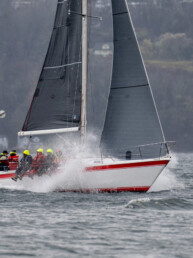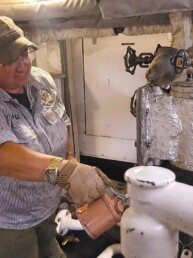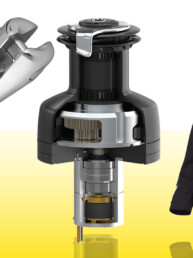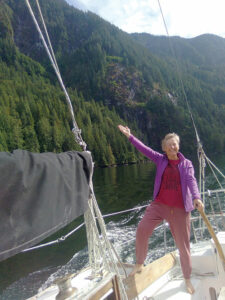
When I first got my 1965 Pearson Triton, I sent my mother an original advertisement for it along with the accompanying text, copied from the official Pearson Yachts website: “Designed by Carl Alberg in 1958, the classic Pearson Triton gained a dedicated following in the boating community that still exists today.”
The mid-century brochure photo is a beautiful black-and-white action shot of the Triton with a billowing, jauntily-striped spinnaker. Two men sit in the cockpit, and two sets of legs are on the foredeck near the mast, torsos obscured by the full sails. My mother would have been 8-years-old when this advertisement was made and I thought it might have a nostalgic appeal for her on some level. Her family had never owned a sailboat, but they had owned a classic airstream trailer, and my mother loved camping.
“Cruising is just like camping, only more exciting and more comfortable,” I told her. She responded enthusiastically that she would buy cushions. I had hoped for something more along the lines of matching Helly Hansen sailing bibs, but I didn’t want to dampen the moment with any reality checks.
Carl Alberg designed the Triton at the request for a “28-footer that sleeps four,” and indeed, there are four aboard in the original brochure photo. But when I first acquired the Triton it could not have slept one. It was moldy, green, and gross, inside and out. I knew it was a diamond in the rough, with its solid fiberglass hull, classic lines, teak accents, and capable design, but this was easily overlooked by those outside the boating community.
During a mid-winter haul out in Lund, British Columbia, I power-washed the decks and then surprised the boatyard employees by climbing into the cabin and power washing the inside as well.
The original layout of the Triton features two long settees down either side of the main cabin and a drop-leaf table between them. With an 8.3-foot beam, she’s a narrow boat, so one of the first things I did was remove the table.
Over the next seven months at the boatyard, I removed nearly every speck of interior and changed the layout — creating a dinette to port and a full-sized galley to starboard. Most importantly, I installed a Dickinson heater; a cute one with a little window to view the glowing flame. My new boat was christened Hecate and, inspired by the mid-century brochure ad, I painted her black-and-white.
My mother and I first went sailing on Hecate that summer, half a year after I’d hauled out and begun the refit. It was a beautiful day and we set out on a beam reach. During the rebuild, I’d removed the Atomic 4 engine. Since I was reluctant to mar the transom by mounting an outboard to it, I decided to go engineless. I tied Hecate behind my rowboat and towed her into open water, then moved the rowboat aft.
We picked up speed, beared away and were soon running with the wind, feeling carefree.
When it was time to return home, we realized that we had broken a rule of engineless sailing: it’s wise to sail upwind on your way out and downwind on your way home.
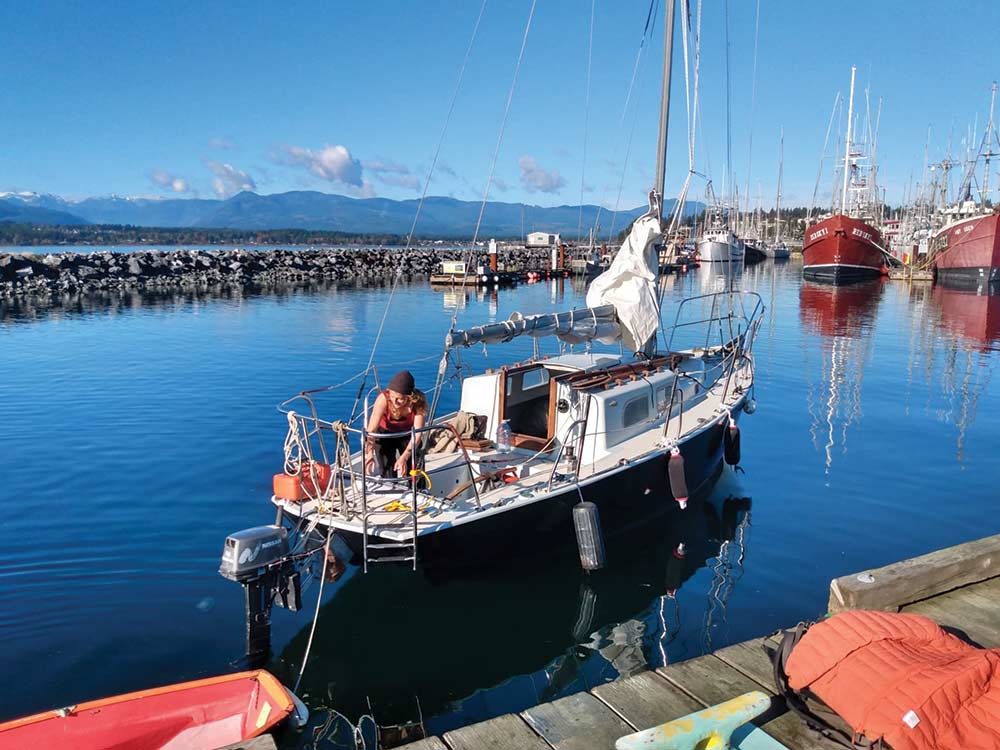
We were both novice sailors and my sails were the original Triton sails that came with the boat — bagged-out after decades of use and decay. We tried to tack upwind, but couldn’t make any headway. To add to our challenge, the wind had picked up and now there was too much chop to row-tow. After half an hour or so of sailing in circles, another sailboat kindly gave us a tow back to the dock.
“It’s a good thing another boat was there,” said my mother. The event had impressed upon her that boats were not like airstream trailers. If the motor died (or had been removed), you didn’t coast to a gentle stop.
That fall I bought an outboard motor, mounted it to Hecate’s transom, and cruised south from Lund all the way to Victoria. My mother followed my progress with her heart in her mouth. She had good reason to worry. The early 2000s two-stroke I’d purchased was an overpriced lemon that was never entirely reliable, and it gave me no end of trouble over the next year that I used it.
I made every rookie mistake in the book, including grounding in the misleadingly named Deep Cove and wrapping my dinghy’s painter in my prop. Through it all, I learned a lot and enjoyed the accomplishment of overcoming trials; while my mother only felt dread.
That winter, I crossed the Strait of Georgia to Vancouver, anchored in False Creek, and spent Christmas with my family. My mother started looking into long-term moorage options for Hecate, eager for me to tie numerous lines to a dock for the season. But I had other ideas. After my two allotted weeks in False Creek had passed, I announced that I would sail north to Pender Harbour, which I hoped to make my home port. This was not long after a winter storm had broken a barge loose from its moorings, beaching it disturbingly on the Vancouver shore. My mother declared that she’d had enough of sitting around worrying — she was going with me.
In mid-January, we began her second voyage on Hecate by motoring out of False Creek, high on the thrill (and relief) that the motor had started at all. We hoisted the jib abreast of anchored containerships and sailed past Bowen Island with big smiles. We anchored in Plumper Cove on Keats Island without incident, just before nightfall and with enough time to row to shore for a brief walk around the island.
Lighting the Dickinson heater scared my mother so, as we settled in for the night, she lit a dozen tea light candles instead. Hecate is so modestly dimensioned that the 12 little flames actually did make it warmer, and cozy. We read aloud some passages from Derek Lundy’s Godforsaken Sea and congratulated ourselves on dipping a toe into this wild world. With the flicker of candlelight, the simple dinner we’d cooked on my camping stove, and the gentle lap of water against the hull, we were having an adventure.
Before the trip, my mother had planned on disembarking in Gibsons — just across Shoal Channel from where we were staying — and catching a bus home. While we were at Keats, however, she decided to make the full journey to Pender Harbour with me. It had been a good day.
The next morning we set off in high spirits, timing our departure with the high tide that would carry us over a shallow portion of Shoal Channel. We were motoring and the day was glassy calm. Ten minutes out, the motor started shaking like a washing machine in its final spin cycle, and then it died. Surprisingly, my mother wasn’t upset the way she would have been if I’d explained the situation over the phone. She took the tiller while I hitched the rowboat to the bow, still faintly smiling. I row-towed us the hour-long distance to Gibsons, a cheery port town on the Sunshine Coast. In summer, a passing boat might have given us a tow, but in the offseason, we had the water to ourselves. We reached Gibsons, tied up to the municipal dock, and called the local chandlery.
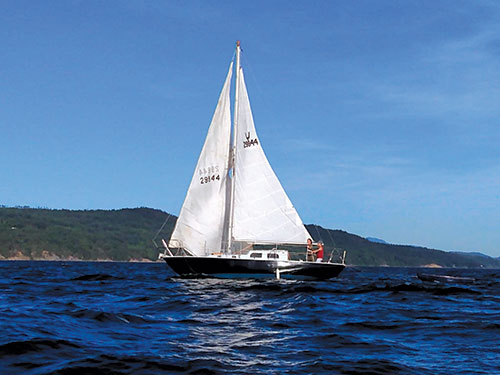
After an assessment, we determined that my outboard’s lower unit needed to be replaced. Miraculously, a local boaters exchange had the right part; which was installed the next morning. When we started the engine, our cheers matched its roar as it came to life. This is how it goes while cruising on a tight budget. I had tried to explain this to my mother many times, but it needs to be lived to be understood.
With a once-again-functioning motor, we enjoyed a 20-mile day of motoring and sailing as we followed the coast northwest. We motored over the shoal and hoisted the sails out in the open strait. Although I have recently spoiled myself with a roller-furling jib, at the time I had only a large and ancient hank-on headsail. While my mother held the tiller, I clipped the jib halyard on to the head and started hoisting. A few pulls later the line jerked to a stop. I’d accidentally clipped the halyard to the jib behind the mast spreaders, and now the halyard was caught some 15 feet in the air. I tried to jerk down the sail itself, but the halyard was snagged on a shroud tang. I announced that I would simply have to shimmy up the mast and yank it loose at the source of the problem — without climbing gear, of course. My mother surprised me by simply agreeing. I pulled myself up the mast, a few inches at a time, until I reached the spreaders, and with my legs wrapped around the mast, yanked the halyard loose from the tang. Hours later, we sailed through Welcome Passage at a brisk six knots — it made the bruises on my shins feel worth it.
At dusk, we agreed to compromise — skipping the intimidatingly narrow entrance to Smuggler Cove. After an intense two days of adventure, Mom didn’t want to run into a cliff face. Instead, we anchored in the much larger, well-populated, and ironically named Secret Cove. We wriggled into our sleeping bags smiling with gratitude and gratification.
The next day we sailed pleasantly, and uneventfully, into Pender Harbour; and we parted ways there.
From that point on, things were different. When I told my mother, over the phone, that the prop on the new leg had spun off — the culprit, a rusty cotter pin — she simply waited to hear the rest of the story. We’ve gone on to do several more sailing trips together — around Cortes Island, up to Princess Louisa Inlet, back and forth between Texada and Lund. Of course, many things have gone wrong, but with every trip we share, we build confidence and create happy memories.
On our most recent trip together, my frustrating outboard motor died once and for all. We continued on, sailing engineless for the full two days to our destination, where I bought a brand-new motor with a three-year warranty. Mom said it was her two favorite days of sailing yet.
Along the way, Hecate has undergone more refits, including the addition of a motor well for my new outboard. I’m looking forward to spring. My first mate and I have more cruising to do.
Emma Biron
Emma Biron lives in Pender Harbour, BC, and can often be seen sailing her Pearson Triton 28 around the harbour and beyond. In addition to sailing, she also loves reading, writing, refits, and rowing.


